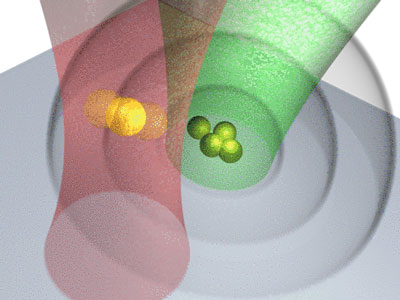| Jan 16, 2012 |
Nanoears - gold nanoparticles detect tiny acoustic vibrations
|
|
(Nanowerk News) How noisy is a walking flea? What sorts of sound waves are caused by motile bacteria? Physicists at the Nanosystems Initiative Munich (NIM) have managed for the first time to detect sound waves at such minuscule length scales.
|
|
Their nanoear is a single gold nanoparticle that is kept in a state of levitation by a laser beam. Upon weak acoustic excitation the particle oscillates parallel to the direction of sound propagation. The scientists led by Dr. Andrey Lutich, who is a member of Professor Jochen Feldmann's group at LMU Munich, managed to detect such tiny displacements using a dark-field microscope and an ordinary video camera. The nanoear is capable of detecting sound levels of approximately -60 dB. Thus, it is about a million times more sensitive than the hearing threshold of the human ear, which by convention is set at 0 dB (see paper in Physical Review Letters: "Optically Trapped Gold Nanoparticle Enables Listening at the Microscale").
|
|
The new method realized by the Munich physicists opens a new world to scientists: for the first time, otherwise imperceptibly weak motions – minuscule sound waves – can be visualized. The scientists developed the nanoear in two stages. "First, we validated the basic principle using a relatively strong sound source" group leader Andrey Lutich explains. "In the second step we were able to detect significantly weaker acoustic excitations." The main element in both cases is a gold nanoparticle, 60 nm in diameter, which is kept in levitation by a so-called optical trap using a red laser. Each of the experiments was done in a small water drop on a cover slide.
|
 |
| In a water drop, an aggregate of gold nanoparticles is heated by a green laser. As a consequence, sound waves are emitted which displace a nearby single nanoparticle that is kept in levitation by a red laser.
|
|
In the first case, a needle serves as a sound source. It is glued onto a loudspeaker membrane and emits sound waves towards the trapped gold particle. The scientists successfully detected the oscillations of the trapped particle optically using a dark-field microscope and an ordinary digital camera. The recorded videos, each 30 seconds in length, clearly showed the particle oscillating parallel to the propagation direction of the sound waves.
|
|
In a second step, the physicists used the so-called nanoprinting method to fix a small number of gold particles on the cover slide. These particles are heated periodically using a green laser. As a result they emit very weak sound waves towards the single levitating gold nanoparticle. The interaction between the sound waves and the trapped particle is very weak. Therefore, the displacement of the particle cannot be detected directly with available optical methods. The scientists used the mathematical Fourier Transformation to obtain the frequency spectrum of the particle's motion. The physicists could show that the frequency of the sound source is clearly enhanced in this spectrum. Control experiments in which the sound source is driven at varying frequencies confirmed this observation and the high sensitivity of the nanoear.
|
|
"With our nanoear, we have developed a nanomicrophone that allows us to get closer than ever to microscopic objects" Alexander Ohlinger, first author of the publication, explains. "By observing the oscillations of a single gold nanoparticle, tiny movements can be detected." In this way, the nanoear could yield important information on the minute motions of cells, cell organelles or artificial microscopic objects. Additionally, no high-end devices are necessary as only well-established methods are used.
|

